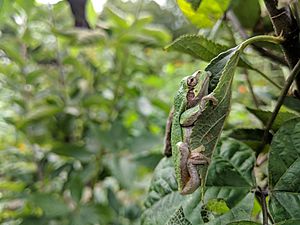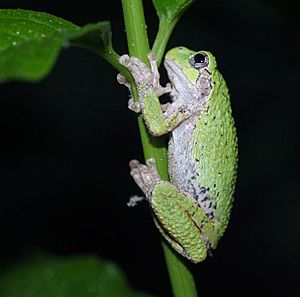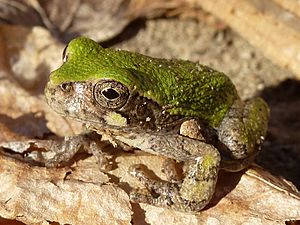Gray treefrog facts for kids
Quick facts for kids Gray treefrog |
|
|---|---|
 |
|
| Conservation status | |
| Scientific classification | |
| Synonyms | |
|
Hyla versicolor LeConte, 1825 |
The gray treefrog (Dryophytes versicolor) is a species of small arboreal holarctic tree frog native to much of the eastern United States and southeastern Canada.
It is sometimes referred to as the eastern gray treefrog, northern gray treefrog, common gray treefrog, or tetraploid gray treefrog to distinguish it from its more southern, genetically disparate relative, Cope's gray treefrog.
Contents
Description
As the scientific name implies, gray treefrogs are variable in color owing to their ability to camouflage themselves from gray to green or brown, depending on the substrate where they are sitting. The degree of mottling varies. They can change from nearly black to nearly white. They change color at a slower rate than a chameleon. One aspect that is unique to this frog appearance is that its legs feature a dark bandish pattern which then contrast sharply with the black-marked bright yellow or orange under the sides of its legs and arms. Dead gray treefrogs and ones in unnatural surroundings are predominantly gray. The female does not call and has a white throat; however, the male does call and can show a black/gray/brown throat during the breeding season. The female is usually larger than the male. It is important to know when trying to identify this frog that the appearance at a younger age is similar to others of the same species, but as the frog increases in age the appearance varies. They are relatively small compared to other North American frog species, typically attaining no more than 1.5 to 2 in (3.8 to 5.1 cm). Their skin has a lumpy texture to it, giving them a warty appearance.
This species is virtually indistinguishable from Cope's gray treefrog, the only readily noticeable difference being that Cope's Gray treefrog has a shorter, faster call. However, the call rates of both gray treefrogs are temperature dependent and at lower temperatures Cope's gray treefrog can have a call rate approximating that of the gray treefrog. The difference in call can be heard, but it is best quantified by counting the number of pulses per second in their whistled trills. The gray treefrog has a pulse rate of 16 to 34 pulses per second while Cope's gray treefrog has a pulse rate of 34 to 60 pulses per second. Even though there is potential for overlap, because of the temperature dependence of the pulse frequency the two species are easily distinguished where they occur together. At a given temperature, the pulse frequency for the gray treefrog is approximately 1/2 that of Cope's gray treefrog.
The gray treefrog also has 48 chromosomes (4n), and is called the tetraploid gray treefrog in scientific literature. Cope's gray treefrog, or diploid gray treefrog, retained its 2n (24) original chromosome count. Hybridization between these species results in early mortality of many larvae, but some individuals survive to adulthood though they have reduced fertility.
Both of these similar species have bright-yellow patches on their hind legs, which distinguishes them from other treefrogs, such as the bird-voiced tree frog. The bright patches are normally only visible while the frog is jumping. Both species of gray treefrogs are slightly sexually dimorphic. Males have black or gray throats, while the throats of the females are lighter.
Tadpoles have rounded bodies (as opposed to the more elongated bodies of stream species) with high, wide tails that can be colored red if predators are in the system. Metamorphosis can occur as quickly as two months with optimal conditions. At metamorphosis, the new froglets will almost always turn green for a day or two before changing to the more common gray. Young frogs will also sometimes maintain a light green color and turn gray or darker green after reaching adulthood.
Distribution and habitat
Gray treefrogs inhabit a wide range, and can be found in most of the eastern half of the United States, as far west as central Texas and Oklahoma. They also range into Canada in the provinces of Quebec, Ontario, and Manitoba, with an isolated population in New Brunswick.
The gray treefrog is capable of surviving freezing of its internal body fluids to temperatures as low as -8 °C.
The gray treefrog is most common in forested areas, as it is highly arboreal. Its calls are often heard in rural residential areas of the East Coast and the Midwest. It prefers to breed in semipermanent woodland ponds without fish, but it also lays eggs in swamps, vernal pools, man-made fountains and water gardens, and even in rainwater-filled swimming pool covers.
Behavior
These frogs rarely ever descend from high treetops except for breeding. They are strictly nocturnal. Male gray treefrogs rarely have large choruses, as they are mostly solitary animals, but might vocalize competitively at the height of breeding periods. Gray treefrogs may congregate around windows and porch lights to eat insects that are attracted to the light. During the day they often rest on horizontal tree branches or leaves out in the open, even in the sun. Evidently they are less prone to overheating and desiccation than other amphibians and rely on their superb camouflage to hide them from predators.
Breeding
Mating calls and chorusing are most frequent at night, but individuals often call during daytime in response to thunder or other loud noises.
In captivity
Needs are similar to that of the American green treefrog.
Images for kids
See also
 In Spanish: Rana arbórea gris para niños
In Spanish: Rana arbórea gris para niños






